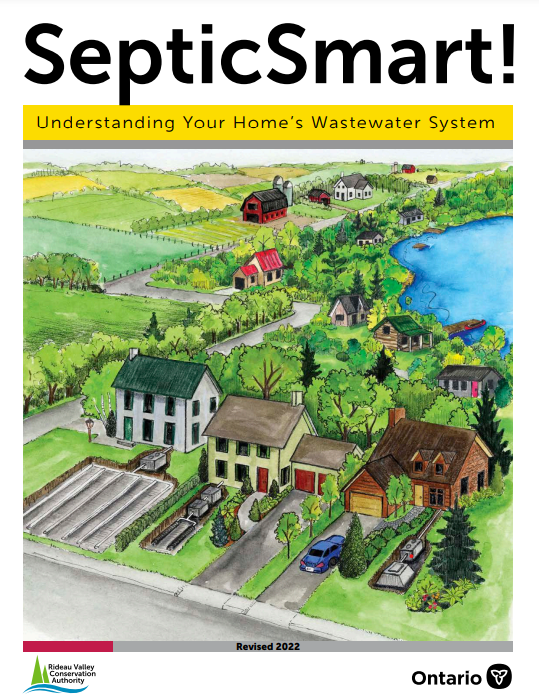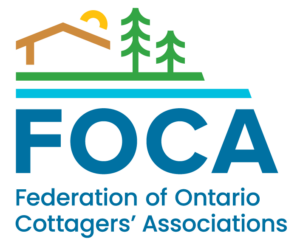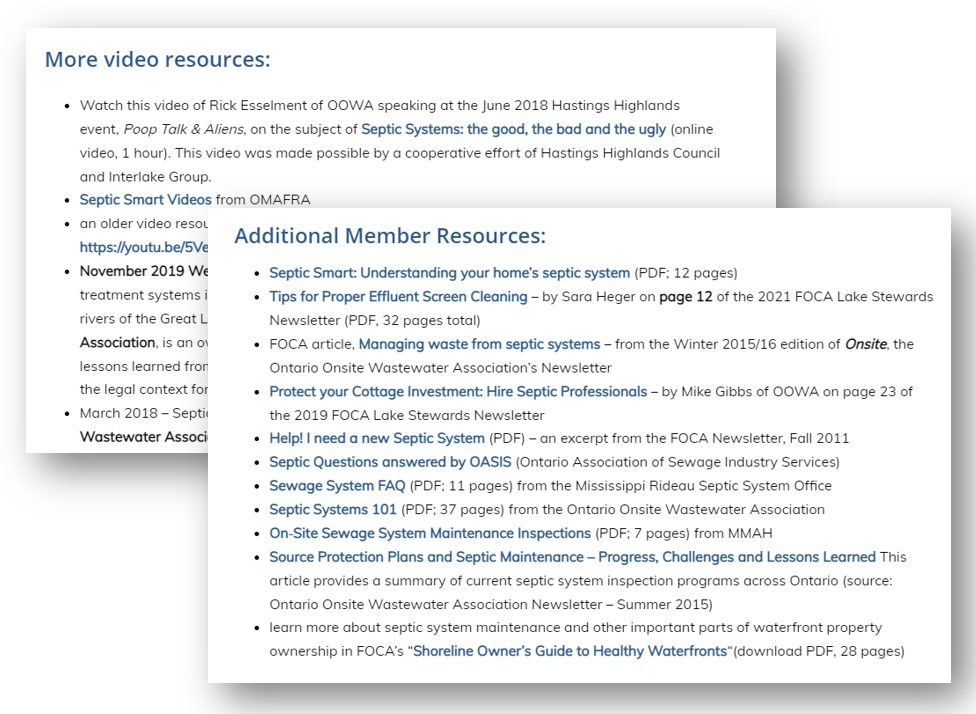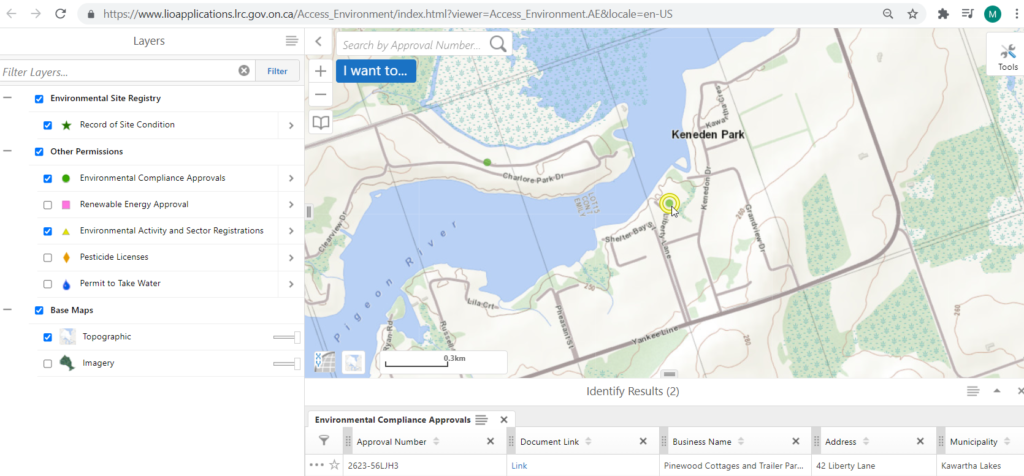
Most of Ontario’s waterfront property owners rely on on-site sewage treatment systems to manage household wastewater.

Understanding how our systems work and the importance of maintaining them is important to protect our lakes and rivers from contaminants.
Septic system construction is regulated under the Ontario Building Code, but maintenance, including pumping and inspection, is a homeowner responsibility. Some regions have mandatory septic inspections every five years by the municipality or conservation authority, and some have grants to help property owners conduct necessary repairs and upgrades, but these are variable across the province.

May 2025 – the recent Conference edition of the Ontario Onsite Wastewater Association’s newsletter includes an article by a building inspector outlining recent changes to the Ontario building code. See pages 20-22: “This change mostly affects northern rural areas within cottage country, where remote properties used to see a combination of a Class 2 system with a Composting toilet as an alternative to installing a Class 4 system.” A grey water disposal pit may no longer suffice, under the changes, making a septic system necessary, at least for new builds.

Take action to ensure your own septic system is in good working order, and stays that way. Some tips:
- have a licensed technician inspect the system, pump out the tank, and install an effluent filter
- remind visitors to avoid putting anything down the drain that might interfere with the system function (examples include: coffee grounds, food scraps, tampons, applicators, flushable wipes, condoms, anti-bacterials, solvents)
- remind everyone to conserve water – large volumes can overload the system and cause failure!
Resources:
Download this information > Septic Systems – a FOCA Factsheet (PDF; 2 pages)
Watch and share this video >
Join over 12,500 viewers and watch this informational video from FOCA and our partners at Peterborough Public Health, about Septic Systems: their parts, maintenance and signs of trouble. Click the video at the side to open it in YouTube.
Access more homeowners resources from our partners at the Ontario Onsite Wastewater Association (OOWA).
Need to find a septic system professional in Ontario? Start on OOWA’s interactive map.
What to Do When Flood Waters Have Affected Your Septic System (Leeds, Grenville & Lanark District Health Unit)
Interested in the subject of septic re-inspections?
Members are invited to login below, to read FOCA’s Report on Septic Re-inspection Programs in Ontario: A Guide for Community Groups (2018).
Infographic: public access:
- Download the infographic summary (PDF, 1 page, under 1 MB)
Full Report: members-only > login below to access it!
The report and accompanying infographic provides statistics and case studies about existing municipal septic re-inspection programs across Ontario. Bring this information to the attention of your local municipal Council!

You're missing members-only content!
The full Septic Re-inspection report is only available to members of our Member Associations & current Friends of FOCA (our annual supporters). Municipal partners may contact us for a copy.
If you are already registered on the FOCA website, please login below with your Username and Password.
Need help with your login? Contact us for assistance during business hours. Not yet a Member Association? Find out why you should be!
FOCA’s Septic Report (above) explores the state of sewage systems across rural Ontario, including:
- representative statistics on the state of Ontario sewage systems
- what a sewage system is designed to do, and why it matters in rural Ontario
- an overview of the septic re-inspection process
- 4 case studies of municipal re-inspection programs.
This report is the culmination of a two-year project with FOCA, university, industry and organizational partners to explore successes, challenges and lessons learned in municipal re-inspection programs across the province.
September 2022 – NEW Septic Smart Brochure (PDF, 5 MB) – FOCA has worked with our industry partners over the past several years to update the popular Septic Smart brochure for homeowners living with an onsite wastewater system. We are very pleased to announce the release of the revised brochure, and encourage everyone to read it.

September 19, 2022 – Our partners at the Ontario Onsite Wastewater Association (OOWA) have been marking Septic Awareness Week with the release of a variety of homeowner resources, including a 5-minute video overview of Do’s and Don’ts for septic systems, and a longer webinar that provides more detail about the parts, positioning, and maintenance septic systems.
An estimated 25% of septic systems across the province are beyond their 30-year design life and are failing to protect ground and surface water, the source of our drinking water. Need an expert? Visit the Ontario Onsite Wastewater Association’s “Find an Expert” search tool.

You're missing members-only content!
The following resources are only available to members of our Member Associations & current Friends of FOCA (our annual supporters).
If you are already registered on the FOCA website, please login below with your Username and Password.
Need help with your login? Contact us for assistance during business hours. Not yet a Member Association? Find out why you should be!
2015 onward: FOCA concerned about septage discharge:
2017 – FOCA participated as part of the Ministry of the Environment and Climate Change (MOECC) Hauled Sewage Policy and Program Review Working Group, alongside technical and policy experts and municipal representatives. The ministry is considering a range of policy approaches regarding hauled sewage in Ontario, including a province-wide approach to deal with the land application of untreated hauled sewage, and geographically based restrictions.
Related Media Coverage:
Oct.2017 – Read a perspective from a septage hauler: “Company hosts open house to clear the air regarding septage.” (Haliburton Echo; reproduced in the Ontario Onsite Wastewater Association’s Fall/Winter 2017 Newsletter)
Feb. 2017 – Where is the poop in Vernon’s water coming from? Genetic testing aims to find out. City hopes to determine sources, devise plan to control contamination (CBC News)
THE BACK-STORY:
FOCA lobbied the Minister of the Environment and Climate Change about septage disposal concerns. “Septage” is the term for waste material contained in or removed from septic systems, sewage holding tanks and portable toilets, currently regulated through Environmental Compliance Approvals issued under the Environmental Protection Act (EPA) and through Ontario’s General Waste Management Regulation (R.R. O. 1990, Reg. 347) under the EPA.
It had come to FOCA’s attention that some resorts in Ontario relying on large on-site (septic) systems to treat their wastewater were permitted by the Ministry to periodically drain their effluent into neighbouring bodies of water! One example was Touchstone Resort on Lake Muskoka, which allegedly was permitted to drain sewage effluent into Lake Muskoka twice a year.
- Read FOCA’s 2015 letter to the Minstry. (PDF, 2 pages)
The Ontario Onsite Wastewater Association (OOWA) wrote about FOCA’s efforts in their October 2015 edition of OnTrack, their Member Bulletin: Download a PDF of the OOWA Bulletin. From that article:
“OOWA is very concerned about this situation and any other case where septic effluent is discharged directly into surface waters -whether permitted or not. OOWA is also concerned that by permitting this activity, the MOECC is setting a dangerous precedent and sending a confusing message to all other onsite system owners who invest time, effort and money in managing their systems in accordance with service contracts, permits and generally accepted best practices. OOWA looks forward to hearing back from FOCA regarding the MOECC’s response and will update the membership when a response is received.”
FOCA met with the Ministry in October 2015 to get clarity on:
- the permitting and oversight related to sewage works discharging to surface waters;
- the permitting and oversight related to land application of septage.
Read notes from FOCA’s Executive Director about the 2015 meeting. (PDF, 3 pages)
An excerpt from the Ministry’s response to FOCA:
“Where unapproved sewage works are encountered, the ministry will work with the owner to help ensure that human health and the environment are protected while necessary steps are being taken to come into compliance. For the purposes of addressing complaints, bringing up concerns etc. about specific sewage works, the MOECC District office(s) are the place to go.”
Access related online information regarding Ministry approvals for environmental compliance approvals (including sewage system projects) by zooming in on this map near your waterbody, and clicking individual dots to open a list of detailed approvals.
~
RELATED MEDIA COVERAGE:
This story was picked up by the Highlander News – In depth: septic fields explained by Lisa Harrison, Contributing writer (The Highlander News, Thursday Aug.27, 2015, page 7)

Please note: the following is archival material, and some links to third-party resources may no longer be active.
January 2024 – Peterborough Public Health (PPH) has announced that the delivery of septic system permitting and inspection will become the responsibility of the municipalities in Peterborough City and County by November 18, 2024, stating: “PPH has provided these building inspection services related to on-site sewage systems for over 40 years, but we are now only one of 11 public health units offering this service.” Read the full PPH announcement on their website.
May 28, 2021 – Highlands East supporting enhanced septic inspections (Haliburton Echo)
December 2020 – Should you use septic tank additives? Get advice from the industry experts at the Ontario Onsite Wastewater Association (OOWA).
April 2019 – Solving our septic dilemma for safe water in rural areas – PETERBOROUGH PUBLIC HEALTH: Rural areas don’t have the same level of protection (Peterborough Examiner) by Dr. Rosana Salvaterra, Medical Officer of Health
2018 – FOCA lobbied for updates to the Ontario Building Code:
The back-story: Having long been concerned about the inadequacy of the Ontario Building Code to deal with Maintenance and Management of onsite sewage systems (septic systems), in early 2018 FOCA, along with the Ontario Onsite Wastewater Association (OOWA) filed a “Request for Review” with the Environmental Commissioner of Ontario.- Read about it in this article from Water Canada
- FOCA’s input to the proposed OBC changes can be found here.
- Media coverage: “Rural residents rally against proposed septic changes,” (Thunder Bay News Watch, April 2017)
With county-wide and provincial measures in place to protect our water sources, Highlands residents and visitors could expect to feel confident about the future health of our more than 600 lakes and numerous wetlands.
And yet a decades-old practice of spreading sewage on fields continues in the county and across Ontario.
Field spreading, or land application, generally occurs in two formats. The most well-known is the application of biosolids, or sludge, onto farmers’ fields as agricultural fertilizer. Biosolids are what remain after raw sewage has been treated with chemicals in municipal wastewater treatment plants to remove pathogens such as bacteria and viruses, and the water content has been returned to the water source. This practice is sanctioned by the Ontario Ministry of Agriculture and Farming (OMAFRA) as a means to add “valuable” nutrients (chemicals and minerals) back into the soil.
The second format is the application of raw, untreated sewage onto fields, whether for agricultural purposes or not. In rural communities this is often the main option for disposing of septic system waste, which is known as septage once it leaves the septic tank.
The Ontario Ministry of Agriculture and Farming works closely with the Ministry of the Environment and Climate Change (MOECC) to administer both practices under the Nutrient Management Act. A Biosolids Utilization Committee (BUC) advises both ministries with support from the Ministry of Health and Long-Term Care and from agricultural and industrial organizations, municipalities and service industries. These include the Rural Ontario Municipal Association (ROMA) and the Ontario Association of Sewage Industry Services (OASIS).
In the Highlands, Minden Hills and Dysart et al manage sewer systems and sewage treatment plants for central areas. Remaining property owners use septic systems. Algonquin Highlands operates a fee-based septage treatment lagoon and Highlands East provides a septage trench at no charge, but these options don’t have enough capacity to absorb all available septic system waste.
This leaves all four municipalities to rely on field spreading for septage disposal.
Provincially, the Environmental Commissioner of Ontario (ECO) works as an independent officer to monitor and report annually on the government’s compliance with the Environmental Bill of Rights.
The ECO’s 2000-01 annual report advised that untreated septage is likely to have much higher concentrations of live pathogens such as bacteria and viruses than does municipal sewage sludge.
This lack of treatment also means that medication residues and disinfectant chemicals may also be present in septage.
Locally, organizations such as the Coalition of Haliburton Property Owners’ Associations (CHA), which represents 50 lake associations on 100 lakes, are working to help property owners maintain healthy septic systems and to monitor lake health.
All four municipalities provide septic installation inspections, and are either developing or investigating formal septic re-inspection programs.
However, it appears municipalities have no real jurisdiction over field spreading. The MOECC is not required to notify property owners or municipalities when field spreading permits are requested or granted. Algonquin Highlands recently obtained a legal opinion regarding a current field spreading site application, in which the township was advised not to pursue a request for zoning and official plan amendments due to a recent, negative Ontario Municipal Board ruling.
As a result of residents’ concerns over the Algonquin Highlands site application, groups such as the Maple, Beech and Cameron Lakes Area Property Owners’ Association (MBC) have begun investigating alternative methods of septage disposal.
Their president, Andy Muirhead, contacted the Federation of Ontario Cottagers’ Associations (FOCA) for support on Aug. 10, and later received permission from FOCA executive director Terry Rees to release his response.
Rees wrote in part that the MOECC has in the past asserted that it is “committed to a phase-out of land application of all untreated septage”, although Rees said this has been deemed impractical “…based on not enough capacity at municipal treatment plants to meet demand, and lack of information about suitable treatment technologies for septage.”
Having been “intimately involved” with development of the Trent Conservation Coalition Source Protection Plan, which includes the Haliburton County watershed, Rees said the source water protection approach “…deals very peripherally with rural water issues, and almost not at all with anything beyond health issues related to municipal water systems.”
So what options are available to concerned citizens?
Rees advised that municipalities, other provincial Planning Act approval authorities, developers and haulers working together can develop municipal septage plans and determine the amount of septage generated, the number of septage treatment facilities available, and septage management solutions.
For the MBC’s part, Muirhead has released an information paper called “The Next Septic Issue: Where Does It All Go and What Do We Do About It?”
In it Muirhead recommends pressuring provincial authorities “…not only to make the application process for septic disposal sites more open and responsive to all our concerns, but to make it easier for our municipal governments to provide safer, better monitored sites with the capacity to receive and treat the wastes we produce.”
Learn more on FOCA’s additional webpages:
Lake Partner Program of Water Quality Monitoring



